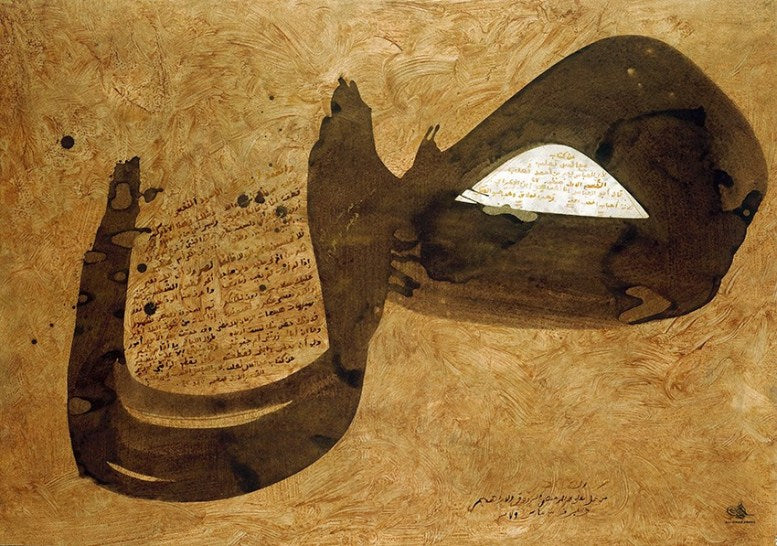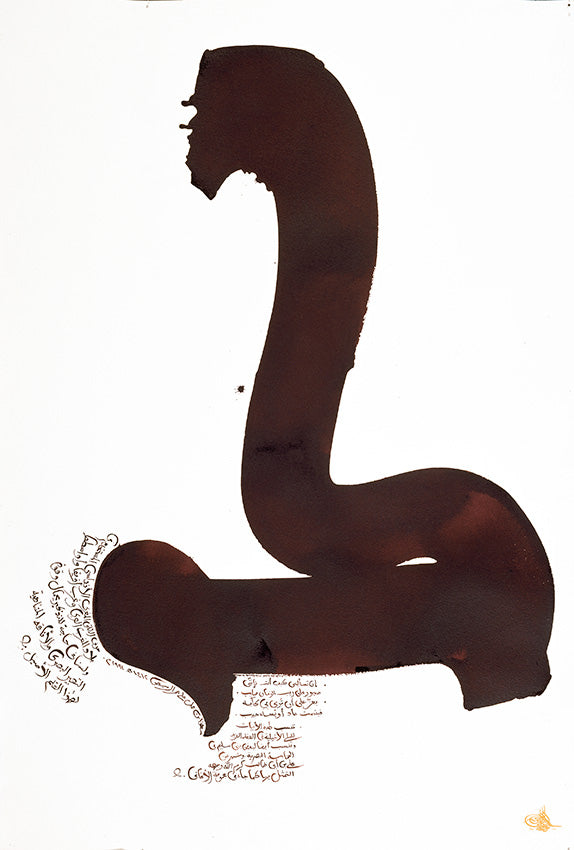This is a piece where I say in it the manifestations of the expression was faster to exist than the elements of execution, so it is a hold up between these two opposing sides, in mono colour full, half and sensitive degrees of impressions.
The poems are from the very rich and well-known reference in Arabic literature – Bahjat Al Majahis by Ibi Abdil Birr Al Qurtobi. The general meaning of the poems is as follows:
Continue Reading →
This bold artwork includes the inscriptions from a poem narrated by the first Abbasid Caliph, Abu Jaafar Al Mansour, he comments on the injustice of the society of the day and laments its unconcern for the plight of the poor.
From Kitab Al Mustatraf and Kitab Al Mu’talaf wa Al Mukhtalaf.
Continue Reading →
Waw is a letter equivalent to the letter W in European languages.
In this work, the emphasis is on the relation between the foreground and the background, where the two elements want to grab the intention of the viewer – as if the two dimensions are one, transparency is the keyword here.
Poems by Muslim Ebni El Waleed, who says in general terms:
Continue Reading →
This artwork displays a powerful relationship between the foreground and background where you feel the growing of detailed colouring and living in the subtlest colours.
Continue Reading →
This artwork shows the grabbing of the expression Lamm, the Arabic equivalent of the English letter L. It has powerful, dominant blows of brush strokes in single colours softened by sensitive swipes in middles tones of the pigment making this complicated piece of art very simple and vice-versa.
Continue Reading →
This artwork contains the inscription from a poem by the poet Al Hutayya promises rewards in this world and the Hereafter for anyone who delivers a good deed (From Al’Aqd al Farid).
Continue Reading →
This piece is an expression of hurt which can be done only by the tongue. While the background expresses its unique position of colour and movement in an unsettling way, between contrast and harmony, between calm and disconcertment, simmering, boiling, as we see in what it can do to us all, the tongue’s wounds are difficult to sooth or to forget.
Continue Reading →

The inscription quotes a poem by Zuhair Ibn Abi Sulma, a pre-Islamic (6th/7th century) poet recognised as a pioneer of fine poetry in Arabic. In these beautiful verses, Ibn Abi-Sulma seeks to placate his wife, Umm Kaab, after a row over his suspected infidelity. He assures her that she is all that is important to him and that she should reconcile and accept his love and attention. The poetical strengths of his poems are further strengthened by the family’s role through several generations of poetry writing in Arabic. Ibn Abi-Sulma’s son, Kaab Ibn Zuhair, is noted for having recited a long poem dealing with affairs of the day in front of the prophet Mohammed (PBUH) in the Medina mosque (from the Daiwan of the poet).
Continue Reading →

The work of the Libyan artist, Ali Omar Ermes, Letter Kaf: The Power of Expression, represents a dramatic departure in its scale, treatment, and intent. Measuring 130.6cm x 94.9cm, the painting is dominated by the form of a single letter of the Arabic alphabet, the letter ‘kaf’ or ‘k’, created with one continuous brush stroke.
Continue Reading →
The inscriptions quote from two movingly eloquent verses on the plight of the world’s poor and the excesses of the rich. The first, by the poet Al-Abbas ibn Al-Ahnaf, says the world has nothing but contempt and hatred for the poor even though his guilt is only the lack of material wealth. So deep is the disdain for the poor, says the poet, that even the dog in the street that wags its tail at a richly attired person seems to run barking after the poor man ready to sink his teeth into his tattered clothes and body.
Continue Reading →
The artwork featured in this article is (on the left-hand side) by Ali Omar Ermes titled ‘Scattered Letters‘ (1969) and is with a private collector and ‘Adhadh in Nasakh Mohawar’ (1991) which is held in a private collection (bottom left).
Dr. James W Allan is the Keeper of Eastern Art, Ashmolean Museum, Oxford
It is a great pleasure for me to introduce the paintings of Ali Omar Ermes. In 1992 I had the privilege of exhibiting his work in the Ashmolean Museum in Oxford, and that experience of both the man and his paintings gave me a new appreciation of the richness and diversity of personality, and of the extraordinary creative ability, with which God has endowed mankind. And yet there are cultural and religious differences which have to be faced if I, as a western Christian, and others like me, are to benefit fully from the paintings of an Arab, Muslim artist.
Continue Reading →

The artworks featured in this article are – ‘Visual Sounds in Arabic Script (1991) part of the Ashmolean Museum Collection, Oxford. ‘Ba Ayoon el-Akhbar’ (1992) in the collection of H.H. Sheikh Hamdan ibn Rashid Maktoom, Dubai. Qaf, “Al Alsmaie Tales” (1983) part of the collection of The National Museum of African Art, The Smithsonian Institute, Washington D.C.
I think that I have seldom been asked to write a comment about an art exhibition which has given me greater pleasure, personal and professional than this fine collection of art works by the famous painter, Ali Omar Ermes. Personal, because I feel like I have known the man for a long time even though I only met him recently in the summer of 1992 in London. Professional, because it is rare for as accomplished a painter to speak so eloquently and with simple clarity about his works.
Continue Reading →

This artwork portrays dramatic contrasts of firm colours with a lively background.
The poems are by the most prominent poet in the 20th century Ahmed Shawqi (d.1932). The poetry could be interpreted as follows:
It is dark, I cannot sleep, and the night stars are watching. Planets, stars, and other objects are crossing through my vision, never mind my worries, across speed and space.
Continue Reading →
"Ghullab: A Reflection on Trials, Movement, and the Quest for Knowledge" is a stunning artwork created in 1998 that invites the viewer to contemplate the trials of the visible and the invisible, the interplay between color and space, and the relationship between the immediate and the non-immediate.
Continue Reading →

An exhibition of the works of a contemporary Arab artist such as Ali Omar Ermes needs some preliminary introduction to a British audience. For his painting has its ultimate source, not in the more familiar traditions of the western world, but the Muslim Arab culture of the Near East and North Africa. To Muslims, divine revelation is enshrined in the Quran, revealed through the Prophet Mohammed (PBUH). That revelation is written in Arabic and, as such, is a transcription of an Arabic Quran which exists in heaven eternally. Hence, the Arabic words of the Quran have an incomparable significance and holiness, far surpassing, for example, the reverence in the past according to the text of the Vulgate (the Latin Bible) in western Christianity. By extension, Arabic word and letterforms, in general, have innate holiness, and the art of Arabic calligraphy takes on unique significance as the artist seeks the perfect curves, the perfect proportions, the perfect spacing of letters for this most holy language.
Continue Reading →














